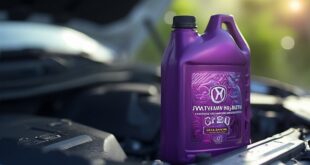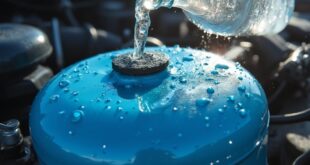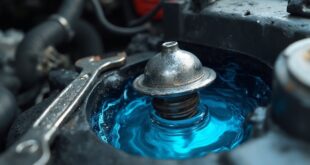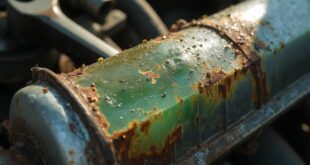The difference between green and orange coolant lies in their chemical compositions and intended uses. Green coolant, using Inorganic Additive Technology (IAT), is suitable for older vehicles, providing protection against corrosion of copper and steel components. In contrast, orange coolant utilizes Organic Acid Technology (OAT) and is designed for newer models with aluminum and nylon parts. Each type has specific characteristics that affect overall vehicle maintenance, which can be explored further.
Definition of Coolant
Coolant is an essential fluid used in vehicles to regulate engine temperature and prevent freezing. It is typically a mixture of antifreeze and water, commonly in equal parts, providing critical protection for the engine.
While water alone can evaporate or freeze, risking severe damage, coolant maintains ideal operating conditions. The color of coolant often indicates its type, with green and orange being the most prevalent.
Each type serves specific vehicle requirements and contributes to the overall performance and longevity of the engine. Understanding coolant's definition is fundamental for proper vehicle maintenance and ensuring efficient engine operation.
Differences Between Green & Orange Coolant
The type of coolant used in a vehicle can greatly impact its performance and longevity.
Green coolant, based on Inorganic Additive Technology (IAT), is typically found in older vehicles, providing effective protection for copper and steel components.
In contrast, orange coolant utilizes Organic Acid Technology (OAT), designed for newer models with aluminum and nylon parts.
The chemical compositions of these coolants differ considerably, influencing their corrosion protection capabilities.
While green coolant is ideal for vehicles manufactured before 2000, orange coolant is specifically formulated for those built thereafter, highlighting the importance of using the correct type for best engine care.
Green Coolant Characteristics
Designed specifically for older vehicles, green coolant plays a crucial role in protecting engine components from corrosion and rust. This coolant utilizes Inorganic Additive Technology (IAT) and contains essential chemicals such as phosphates and silicates. Phosphates help in removing grease and softening water, while silicates serve as sealants, preventing wear and moisture infiltration.
| Component | Function | Benefits |
|---|---|---|
| Phosphates | Grease removal | Enhanced cleanliness |
| Silicates | Sealant against wear | Longevity of seals |
| Glycols | Antifreeze properties | Temperature regulation |
| IAT | Corrosion prevention | Protection for metals |
Orange Coolant Characteristics
Orange coolant is formulated to protect newer vehicles that typically contain less metal than older models.
It utilizes Organic Acid Technology (OAT), which incorporates carboxylates to minimize corrosion while ensuring compatibility with non-metallic components.
Introduced in the 1990s, particularly with GM's DexCool, orange coolant is designed for efficient performance in modern engines.
However, it permits oxygen entry when levels are low, potentially leading to internal damage.
Regular monitoring is essential to prevent clogs and maintain ideal functionality.
This coolant offers a distinct formulation, specifically catering to the needs of contemporary automotive designs and materials.
Coolant Maintenance and Mixing
While maintaining coolant systems, it is essential to avoid mixing different types of coolant, such as green and orange, as this can lead to the formation of a damaging gel.
This gel impedes proper system cycling, ultimately resulting in overheating and potential engine damage. Regular maintenance, including coolant flushes, is vital in preventing such issues.
The intervals for these flushes depend on the vehicle's specifications, with newer coolants often lasting up to 100,000 miles or five years.
Neglecting coolant maintenance can lead to costly repairs, such as water pump replacements, which can range from $450 to $700.
Frequently Asked Questions
Can I Switch From Green to Orange Coolant Easily?
Switching from green to orange coolant is not advisable without thorough flushing. Mixing different coolant types can create harmful gel, leading to overheating and potential engine damage. Proper maintenance is essential to guarantee peak performance.
How Often Should I Check My Coolant Levels?
Regular coolant level checks are essential for vehicle maintenance. Experts recommend inspecting levels every month or before long trips. Keeping coolant at appropriate levels helps prevent overheating and guarantees peak engine performance throughout its lifespan.
What Happens if I Use the Wrong Coolant?
Using the wrong coolant can lead to severe engine damage. It may cause corrosion, overheating, or the formation of clogs. This results in costly repairs and potentially compromises the vehicle's overall performance and longevity.
Are There Any Signs of Coolant Contamination?
Signs of coolant contamination include a discolored appearance, oily residue on surfaces, or a sweet smell. Additionally, overheating engines and frequent coolant loss may indicate contamination, necessitating immediate inspection and maintenance to prevent further damage.
Can I Make My Own Coolant Mixture?
One can create a homemade coolant mixture using a combination of antifreeze and distilled water, typically in equal parts. However, it's essential to guarantee compatibility with vehicle specifications to avoid potential engine damage.
 Car Service Land Coupons for Oil change, Tires, Wheel alignment, Brakes, Maintenance
Car Service Land Coupons for Oil change, Tires, Wheel alignment, Brakes, Maintenance




